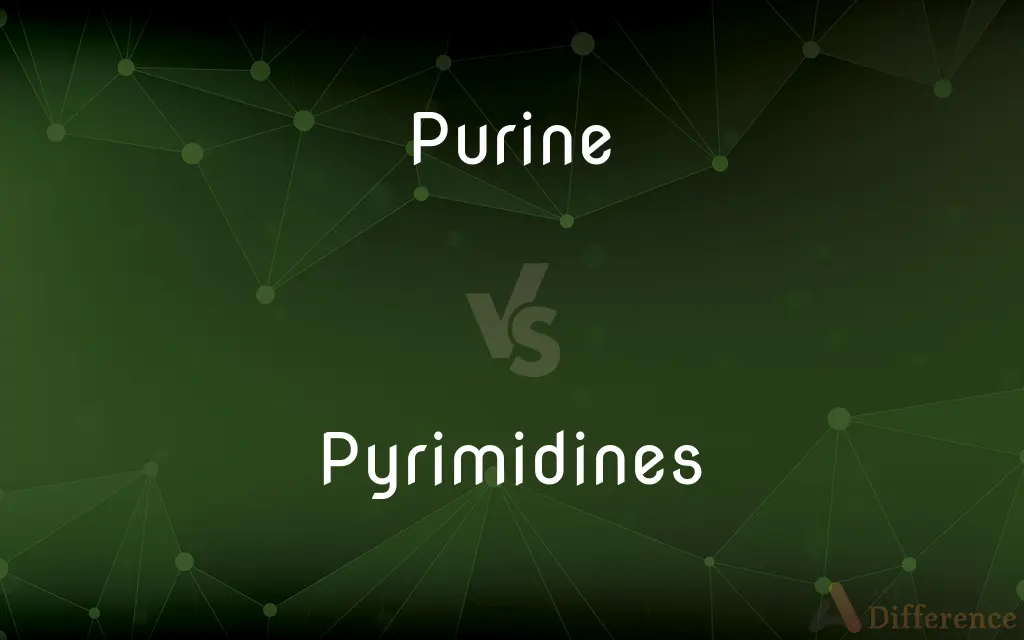Purine vs. Pyrimidines — What's the Difference?
By Urooj Arif & Fiza Rafique — Updated on April 29, 2024
Purines, consisting of adenine and guanine, are double-ringed bases in DNA and RNA; pyrimidines, which include cytosine, thymine, and uracil, are single-ringed.

Difference Between Purine and Pyrimidines
Table of Contents
ADVERTISEMENT
Key Differences
Purines, like adenine (A) and guanine (G), have a double-ringed structure consisting of a fused imidazole and pyrimidine ring. This makes them larger and more complex molecules. On the other hand, pyrimidines, such as cytosine (C), thymine (T), and uracil (U), have a single six-membered ring, making them simpler and smaller compared to purines.
In DNA, purines always pair with pyrimidines through hydrogen bonding, ensuring a consistent structure of the DNA strand. Adenine pairs with thymine via two hydrogen bonds, and guanine pairs with cytosine via three hydrogen bonds. Whereas in RNA, uracil replaces thymine and pairs with adenine, maintaining the general rule of purine-pyrimidine pairing.
Purines and pyrimidines are also crucial in the regulation and synthesis of nucleotides and nucleic acids. Purines are synthesized as nucleotides (the monomer units of nucleic acids), whereas pyrimidines are synthesized as free bases and later attached to a ribose sugar to form a nucleotide.
Biochemically, the synthesis pathways of purines and pyrimidines are different. Purine synthesis begins with the ribose-phosphate backbone and adds atoms to form the complete base, whereas pyrimidine synthesis starts with the base itself and then attaches it to the ribose-phosphate.
In cellular metabolism, both purines and pyrimidines undergo catabolism, but the products and pathways differ. The end products of purine catabolism include uric acid in humans, which can contribute to gout if excessively accumulated. Pyrimidines, when broken down, produce beta-amino acids and carbon dioxide, which are less likely to cause clinical conditions.
ADVERTISEMENT
Comparison Chart
Basic Structure
Double-ringed
Single-ringed
Components
Adenine, Guanine
Cytosine, Thymine, Uracil
DNA Pairing
A with T, G with C
C with G, T with A
Synthesis Starting Point
Ribose-phosphate backbone
Free base formation
Catabolism End Products
Uric acid
Beta-amino acids, CO2
Compare with Definitions
Purine
A type of organic compound with a double-ringed structure.
Adenine and guanine in DNA are purines.
Pyrimidines
Found in foods like beans, peas, and grains.
A diet high in pyrimidine sources is less likely to contribute to gout.
Purine
Involved in energy transfer within cells.
ATP, a key energy molecule, is a purine nucleotide.
Pyrimidines
A type of organic compound with a single-ringed structure.
Cytosine, thymine, and uracil are pyrimidines.
Purine
Found in high concentration in meat and meat products.
Consuming too much purine-rich food can increase gout risk.
Pyrimidines
Crucial for DNA and RNA structure stability.
Pyrimidines help maintain the integrity of genetic information.
Purine
Acts as a precursor in the synthesis of nucleic acids.
Purine nucleotides are essential building blocks of genetic material.
Pyrimidines
Synthesized from simpler organic molecules.
Pyrimidine synthesis involves the assembly of the ring from bicarbonate and ammonia.
Purine
Participates in DNA and RNA formation.
Purines pair with pyrimidines to form the genetic code.
Pyrimidines
Broken down into non-toxic compounds.
The catabolism of pyrimidines produces substances easily excreted by the body.
Purine
Purine is a heterocyclic aromatic organic compound that consists of two rings (pyrimidine and imidazole) fused together. It is water-soluble.
Pyrimidines
A single-ringed, crystalline organic base, C4H4N2, that is the parent compound of a large group of biologically important compounds.
Purine
A colourless crystalline compound with basic properties, forming uric acid on oxidation.
Pyrimidines
Any of a group of substituted derivatives of pyrimidine, including the nitrogen bases uracil, cytosine, and thymine, which are components of nucleic acids. Barbiturates and certain other drugs are also pyrimidines.
Purine
A double-ringed, crystalline organic base, C5H4N4, that is the parent compound of a large group of biologically important compounds.
Pyrimidines
Plural of pyrimidine
Purine
Any of a group of substituted derivatives of purine, including the nitrogen bases adenine and guanine, which are components of nucleic acids. Uric acid, caffeine, theobromine, and theophylline are also purines.
Purine
(organic compound) Any of a class of organic heterocyclic compounds, composed of fused pyrimidine and imidazole rings, that constitute one of the two groups of organic nitrogenous bases (the other being the pyrimidines) and are components of nucleic acids.
Purine
Any of several bases that are derivatives of purine
Purine
A colorless crystalline nitrogen-containing organic base; the parent compound of various biologically important substances
Common Curiosities
What foods are high in purines?
Foods high in purines include red meats, seafood, and some types of beans.
Why are purines paired with pyrimidines in nucleic acids?
Pairing purines with pyrimidines maintains a uniform width of the DNA double helix, crucial for the consistency of genetic information.
What is the consequence of excessive purine breakdown in humans?
Excessive breakdown of purines can lead to the accumulation of uric acid, potentially causing gout and kidney stones.
Can pyrimidines become toxic if accumulated?
Unlike purines, pyrimidines generally break down into non-toxic compounds that are easily excreted from the body.
What is the significance of hydrogen bonds between purines and pyrimidines in DNA?
Hydrogen bonds between purines and pyrimidines ensure the DNA double helix is stable and carries genetic information accurately.
What role do purines play in energy transfer?
Purines such as adenosine triphosphate (ATP) are crucial for energy transfer within cells, powering various cellular activities.
What are common sources of pyrimidines in the diet?
Common dietary sources of pyrimidines include grains, fruits, and vegetables.
Can both purines and pyrimidines form nucleotides?
Yes, both purines and pyrimidines form nucleotides, which are the basic building blocks of nucleic acids like DNA and RNA.
How are purines synthesized in the body?
Purines are synthesized via a multi-step pathway that starts with the ribose-phosphate backbone and adds atoms to build the purine nucleotide.
What happens to pyrimidines during DNA replication?
During DNA replication, pyrimidines are copied to ensure that each new DNA strand contains the necessary genetic instructions.
What replaces thymine in RNA, and why?
Uracil replaces thymine in RNA because RNA is generally single-stranded and uracil makes RNA more chemically stable under physiological conditions.
What is a key difference in the catabolism of purines vs. pyrimidines?
The catabolism of purines results in the production of uric acid, while pyrimidines break down into beta-amino acids and carbon dioxide.
What are the implications of purine and pyrimidine imbalances in DNA?
Imbalances in purine and pyrimidine levels can lead to mutations and instability in the DNA structure, potentially causing genetic disorders.
How does the synthesis of purines differ from that of pyrimidines?
Purine synthesis involves the assembly of a ring attached to a sugar molecule, whereas pyrimidine synthesis starts with the ring itself before it is attached to the sugar.
How do the roles of purines and pyrimidines differ in cellular metabolism?
Purines primarily function in energy storage and transfer, whereas pyrimidines are key structural elements in DNA and RNA.
Share Your Discovery

Previous Comparison
Transfer vs. Transmission
Next Comparison
Sequel vs. PrequelAuthor Spotlight
Written by
Urooj ArifUrooj is a skilled content writer at Ask Difference, known for her exceptional ability to simplify complex topics into engaging and informative content. With a passion for research and a flair for clear, concise writing, she consistently delivers articles that resonate with our diverse audience.
Co-written by
Fiza RafiqueFiza Rafique is a skilled content writer at AskDifference.com, where she meticulously refines and enhances written pieces. Drawing from her vast editorial expertise, Fiza ensures clarity, accuracy, and precision in every article. Passionate about language, she continually seeks to elevate the quality of content for readers worldwide.
















































